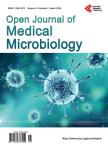Occurrence of Typhoidal and Non-Typhoidal Salmonellae among Poultry Workers in the Southern, Nigeria
Occurrence of Typhoidal and Non-Typhoidal Salmonellae among Poultry Workers in the Southern, Nigeria作者机构:Department of Microbiology Akwa Ibom State University (AKSU) Mkpat Enin Nigeria Health Initiative for Stability & Safety in Africa (HIFASS) Uyo Nigeria
出 版 物:《Open Journal of Medical Microbiology》 (医学微生物学(英文))
年 卷 期:2019年第9卷第4期
页 面:201-214页
学科分类:1002[医学-临床医学] 100201[医学-内科学(含:心血管病、血液病、呼吸系病、消化系病、内分泌与代谢病、肾病、风湿病、传染病)] 10[医学]
主 题:Poultry Salmonella Poultry Workers Antibiogram
摘 要:Typhoid fever and non-typhoidal salmonellosis remain endemic in most developing countries with large scale transmission through contaminated food and drinking water. Since the early 2000s, poultry has also been found to be a common food source for Salmonella enteritidis infections. A total of 500 blood, stool, cloaca swab and egg shell swab specimens were collected respectively from poultry, non-poultry workers and birds in Akwa Ibom State and screened for Salmonella species using standard cultural and serological techniques. The overall prevalence rate was 117 (23.4%). Salmonella species were distributed in all the three senatorial districts of the State, percentage distribution of Salmonella isolates was 42 (25%) for Uyo, 35 (20.8%) for Eket and 40 (23.8%) were isolated from Ikot Ekpene senatorial districts. Out of 372 human subjects screened 77 (20.7%) were positive and 38 (20.4%) were isolated from non-poultry workers while 39 (21.0%) were isolated from poultry Staff in the three senatorial districts. Out of 128 samples of poultry products analysed 40 (31.3%) were isolated. 23 (18%) were isolated from cloaca swabs while 17 (13.3%) were isolated from egg shell swabs. In this study, all the serological significant Typhoid fever cases were confirmed by blood culture. According to sero-grouping and source of sample collection 23.9% S. typhi was isolated from human followed by S. paratyphi A (20.5%) while S. enteritidis and S. gallinarum (19.7%). Among poultry products S. gallinarum, S. enteritidis, S, pullorum, S. paratyphi A, and S. typhimurium were isolated from bird Cloaca swab and Egg shell swab. Salmonella pullorum and S. typhi were not isolated from human and poultry respectively. High prevalence of Salmonella serovars such as S. gallinarium, S. typhi, S. Typhimurium and S. enteritidis with regular consumption of poultry and eggs without proper disinfection and appropriate boiling represent a serious public health risk in Akwa Ibom State. Demographic data obta



